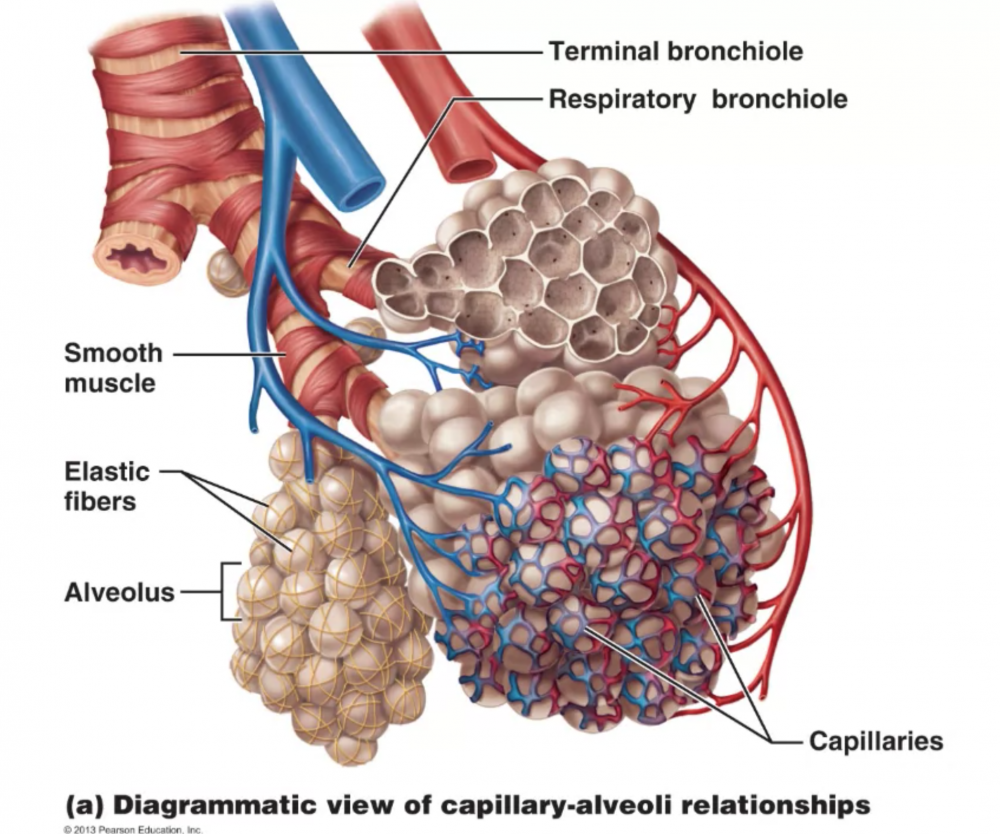AnnYuan
記錄生活點滴,分享旅途快樂Week 5, 生命體征 - 呼吸頻率
人類呼吸係統是如何工作的?呼吸係統負責為身體細胞提供氧氣,以及排出二氧化碳,
一,呼吸係統:是由鼻子、鼻腔、咽、喉、氣管、支氣管和肺組成。

o 鼻孔nares (nostrils)
o 鼻腔 nasal cavity
o 咽 pharynx
♣ 鼻咽部 nasopharynx
♣ 口咽部 oropharynx
♣ 喉咽 laryngopharynx
o 喉 larynx
♣ 會厭 epiglottis
• 在吞咽過程中,會厭複蓋喉部的開口,將吞咽的東西引導至食道esophagus
o 氣管 trachea
♣ 分支形成左右主支氣管the right and left primary bronchi
♣ 初級支氣管分支形成次級支氣管secondary bronchi
• 2 個左次級支氣管 (左肺小一些,2葉)
• 3 個右次級支氣管 (右肺3葉)
首先空氣從鼻子進入人體,鼻子中的上皮細胞產生粘液,能濕潤空氣,而血管具有一定熱量,可使進入鼻孔的空氣變得溫暖。鼻孔黏液還會保留任何可能入侵肺部的汙垢和病原體,同時,鼻子內部還有數百萬個嗅覺感受器,幫助我們嗅聞周圍環境。
空氣從鼻孔吸入穿過咽喉進入氣管,咽和喉連接鼻腔和氣管,也確保人體空氣通道在呼吸時保持開放狀態,聲帶位於喉內,當空氣穿過喉嚨,處於聲帶之上時,就能發出聲音。
氣管是一根由C形軟骨環和平滑肌支撐的長管,氣管內部充滿了黏液,同樣是為了防止外來顆粒進入身體,可以確保空氣保持濕潤狀態。當吸入空氣向下進入氣管時,氣管分裂成支氣管,支氣管又進一步分裂成細支氣管,空氣通過不同的支氣管通道進入肺部。該情況一直持續到細支氣管,抵達肺泡。
你知道右肺比左肺略微大一些嗎?左肺較窄,因為它要為心髒騰出空間,而心髒稍微向左傾斜。然而,右肺比左肺短而寬,因為肝髒在其右下方,由於右肺更大,它比左肺為身體提供更多氧氣。
二。 呼吸機理
肺泡是氣體交換發生的地方,它們是充滿空氣的囊狀結構,有點像氣球,它們與毛細血管相接觸,毛細血管將缺氧和富含二氧化碳的血液送到肺部。


呼吸依賴於一個重要原理——壓力差,肺內部壓力與外部環境壓力之間的差異決定了空氣是流入還是流出肺部,這種壓差是通過改變肺的容積而產生的,壓強和體積是成反比的,所以體積越小,內部壓強就越大。
inhalation吸氣-
吸氣時可使肺部擴張,從而導致肺內部壓力低於大氣壓力,自然地,空氣會從一個壓力較高區域流向一個壓力較低區域,這意味著外部空氣會進入肺部。在肺部中,氧氣分壓較高,而在血管中,氧氣分壓較低,因此,氧氣會從肺泡中轉移至血管中,因為肺泡中有較高的分壓。同樣,二氧化碳的分壓在血管中較高,在肺泡裏較低,所以它會從血管流向肺泡。這種氣體交換在肺部大約5億個肺泡中不斷發生,通過肺泡富含氧氣將傳輸到身體其他部位,為細胞提供氧氣。
- 吸入是一個主動的過程inhalation is an active process
- quiet inspiration –包括收縮:diaphragm隔膜,external intercostal muscles肋間外肌
- forced inspiration用力吸氣,需要額外的骨骼肌skeletal muscles:
Sternocleidomastoid 胸鎖乳突肌,scalenes斜角肌,pectoralis minor胸小肌
exhalation呼氣-
為了排出二氧化碳氣體,肺部會向內收縮,從而減少了肺內容積,從而增加了壓力,這個壓強現在比大氣壓強大,所以空氣會從肺部排出,進入空氣之中。這樣,就形成了一個完整的呼吸循環係統。
1. quiet exhalation is a passive process- elastic tissue retracts to normal position。安靜的呼氣是一個被動的過程——彈性組織收縮到正常位置。如果一個人用力呼吸,呼氣也會變成一個積極的過程。
2.forceful exhalation用力呼吸 –skeletal muscles involved涉及骨骼肌:
muscles of the abdominal wall 腹壁肌肉
internal intercostals內肋間肌
muscles of the abdominal wall 腹壁肌肉
pleura 胸膜-
pleurae are one example of a serous membrane漿膜- thin membrane layer that covers the outer surface of organs in the body cavity, then reflects outward to line the cavity胸膜是漿膜層的一個例子,它覆蓋體腔內器官的外表麵,然後向外反射以排列腔體.
visceral pleura 髒胸膜
parietal pleura 壁層胸膜
pleural cavity胸膜腔 –a thin potential space which is filled with pleural fluid胸膜液 that is secreted by the pleural membranes胸膜
三。 The Mechanics of Breathing呼吸力學
Inhalation-吸氣
*chest wall moves out and up, stretching the elastic tissue胸壁向外向上移動,拉伸彈性組織;
*lung volume increases肺容量增加 - decrease in intrapulmonary pressure 肺內壓減低
*when intrapulmonary pressure is less than atmospheric pressure, air flows into lungs 當肺內壓低於大氣壓時,空氣流入肺部
Exhalation呼氣
*lung volume decreases肺容量減小 - increase in intrapulmonary pressure 肺內壓增高
*when intrapulmonary pressure is greater than atmospheric pressure, air flows out of the lungs當肺內壓大於大氣壓時,空氣會從肺部流出
spirometry tracing肺活量追蹤:
*tidal volume –average adult tidal volume = 500 mL 潮量,自然呼吸
*inspiratory reserve volume吸氣儲備量
*expiratory reserve volume呼氣儲備量
*vital capacity肺活量
*residual volume 殘餘量–volume of air left in the lungs at the end of a forceful exhalation 用勁呼氣後還會有餘氣,不然肺泡再鼓起就有困難。
*a greater resistance in the respiratory system makes it more difficult to move air in and out of the airways
*bronchoconstriction支氣管收縮:
parasympathetic nervous system副交感神經係統-
*bronchodilation支氣管擴張:
sympathetic nervous system交感神經係統


當我們談論氣體交換時,我們談論的是氣體沿著其分壓梯度擴散。現在在肺部,如果我們隻考慮循環方麵的情況,想想我們有脫氧血液回到右心房, 然後流入右心室。當心室收縮時,血液會噴射到肺幹。然後肺幹會分叉成左右肺動脈,將血液輸送到左右肺,對吧?在肺內,肺動脈會分裂,分裂,分裂成越來越小的血管,直到最後到達發生氣體交換的肺毛細血管的水平。現在進入肺毛細血管的血液是脫氧血液。它還含有氧氣嗎?當血液在整個體循環中形成回路時,它確實會向組織釋放一些氧氣,但不會釋放出它所含的所有氧氣,所以它的含氧量比它通過肺部吸收氧氣後的含氧量要低。在脫氧血液中會有更多的二氧化碳。因為當血液通過體循環進行循環時,它會通過進行新陳代謝的組織。二氧化碳是細胞代謝的最終產物之一。所以血液會吸收二氧化碳,從而會有更高的二氧化碳分壓。所以氧氣將從分壓較高的肺泡擴散到流經肺毛細血管的血液中。二氧化碳會從肺毛細血管血液擴散到肺泡,這樣,兩種氣體都沿著它們的分壓梯度擴散。血液流過那些肺毛細血管,肺毛細血管會聚形成毛細血管後到小靜脈,這些小靜脈會聚形成更大的小靜脈。小靜脈匯合形成靜脈。最終,肺靜脈將新氧合的血液帶出肺部,輸送到左心房。血液從左心房流入左心室。左心室,當心室收縮時,左心室會將血液射入主動脈。然後血液會從主動脈流入更小的動脈。動脈將分叉、分叉、分支、分叉。最後到達全身毛細血管,現在氣體交換也發生在全身毛細血管中。同樣,氣體將沿著其分壓梯度向下擴散,但由於氧氣現在將在全身血液中具有更高的分壓,氧氣將擴散到細胞中。二氧化碳將從細胞擴散到全身毛細血管的血液中。 所以氣體交換發生在肺毛細血管和全身毛細血管中。
五,Regulating Respiration Rate 調節呼吸頻率
Control of respiration rate:
chemoreceptors化學感受器 –the specialized chemoreceptors that monitor changes in O2, CO2, and pH of body fluids體液 pH 值
* peripheral chemoreceptors 外周化學感受器
located in the aortic and carotid bodies位於主動脈和頸動脈體
monitor the chemistry of systemic arterial blood監測全身動脈血化學
* central chemoreceptors 中樞化學感受器
in the brainstem near the control centers for respiration rate在呼吸率控製中心附近的腦幹中
monitor changes in the cerebrospinal fluid 監測腦脊液的變化
通常,中樞化學感受器在調節呼吸速率中起主要作用。
chemical factors influencing respiration 影響呼吸的化學因素
* carbon dioxide
increased pCO2 二氧化碳分壓in systemic arterial blood全身動脈血 is the most powerful stimulus最強大的刺激 for regulation of respiration rate
it is the central chemoreceptors that are most sensitive to increased pCO2 in arterial blood 對動脈血中二氧化碳分壓升高最敏感的是中樞化學感受器。
增加的二氧化碳分壓會間接影響中樞化學感受器—通過降低腦脊液的 pH 值
* oxygen
pO2 may fall low enough to stimulate respiration in certain clinical situations (i.e. pneumonia, congestive heart failure) 在某些臨床情況下(如肺炎、充血性心力衰竭),氧分壓 可能會降低到足以刺激呼吸
it is peripheral chemoreceptors that are most responsive to increased pO2 in arterial blood 對動脈血中增加的 pO2 最敏感的是外周化學感受器。
* pH
- acids (free H+) are generated in the body via metabolism 酸(遊離 H+)通過新陳代謝在體內產生. examples of these types of acids are lactic acid & ketoacids乳酸和酮酸 .
-peripheral receptors are most responsive to the decreased pH associated with accumulation of metabolic acids 外周受體對與代謝酸積累相關的降低的 pH 值最敏感.
regulating respiration
when chemoreceptors are activated, they increase activation of respiratory centers in the medulla of the brainstem, this results in increased neural impulses to respiratory muscles.當化學感受器被激活時,它們會增加腦幹髓質中呼吸中樞的激活,這導致呼吸肌的神經衝動增加.
- under normal circumstances, the indirect activation of central chemoreceptors by the increased pCO2 of systemic arterial is the primary stimulus regulating respiration 在正常情況下,全身動脈 pCO2 升高間接激活中樞化學感受器是調節呼吸的主要刺激.
- chronic obstructive pulmonary disease 慢性阻塞性肺病 (COPD) –condition in which there is impaired recoil ability of lung tissue肺組織的反衝能力受損的情況.
also, in patients with COPD, there is a destruction of alveolar walls - enlarged air pockets 肺泡壁被破壞 - 氣囊擴大. these enlarged air pockets cause increased dead space in lungs --i.e., these spaces are not involved in gas exchange 這些擴大的氣穴導致肺部死腔增加—即這些空間不參與氣體交換.
- slower, deeper breaths (versus shallow, rapid breaths) is more efficient at getting more fresh gas into the alveoli更慢、更深的呼吸(相對於淺而快的呼吸)更有效地將更多新鮮氣體吸入肺泡.
七,臨床表現
當醫生用聽診器在你的前胸後背, 上上下下,聆聽你的呼吸音, 判斷你的呼吸音正常還是異常。 如果有人患有肺炎或肺水腫(pulmonary edema),您可能會聽到他們的肺部積液,所以聽起來真的像劈啪聲或輕微的爆裂聲,羅音Crackles 。哮喘病患者胸部能聽到wheezing喘息聲。
患有不受控製的糖尿病的人無法正常代謝血糖,並嚴重依賴脂肪作為燃料。結果,它們的脂肪分解代謝速度加快並產生了更多的酮。酮是一種代謝酸,可作用於外周化學感受器,導致呼吸速率增加。生酮飲食的人經常尿裏能查到酮體,是不是會引起心跳加速呢?




